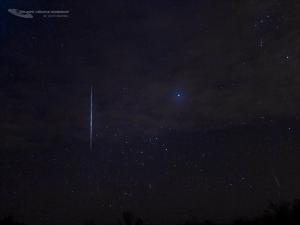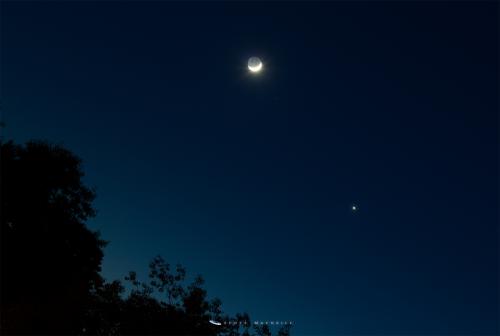Celebration of Space - December 6, 2019
This coming Tuesday and Wednesday, December 10 and 11, 2019, conjunctions will continue. This time it will be Venus and Saturn that are putting on a celestial dance. About 30 minutes after sunset on each night, step outside and look to the SW. You will notice a super bright star, that’s actually Venus. About 1.5° below will be the much dimmer Saturn. Since the December Full Moon (Full Cold Moon) will occur on December 11th, the Moon will not be part of the conjunction. Though it will still be worth a cold trip outside to catch a subtle view. If you happen to catch a photo of the conjunction, post it on the Frosty Drew Observatory Facebook page, and we’ll share it on our timeline.
Overnight next Friday, December 13-14th, gear up for a night of shooting stars and frigid temps as the fabled Geminid Meteor Shower peak is coming to the skies over planet Earth. Producing upwards of 150 meteors per hour under perfect conditions, this is the most active regular meteor shower of the year. This year the 96% waning gibbous Moon will rise at 5:52 pm and will outshine all but the brightest meteors. Though the Geminid shower is so active, that even with a bright Moon, numerous meteors can still be seen, just don’t expect 150 per hour.
Unlike most meteor showers, which originate from comets, Geminid meteors originate from an asteroid - 3200 Phaethon. The asteroid was discovered on October 11, 1983, is only 3.17 miles in diameter and has a 1.4 year orbital period around the Sun. 3200 Phaethon is quite the misfit asteroid as well. Sporting a highly elliptical orbit, it has led scientists to suspect it may be a dead comet. Though when passing at its closest to the Sun (perihelion) it does not form a comet-like tail or tenuous atmosphere (coma). Regardless of the strangeness that surrounds 3200 Phaethon, one thing is certain. It leaves behind a fabulously dense debris field that fuels the mid-December meteor spectacular for all of us watchers on Earth.
This year, expectations will be a bit low considering we have a bright Moon for the entire night. Though this is not a reason to skip out on the shower. Meteors should start to pick up after 10:00 pm on December 13th. Meteors will appear to originate from the bright star Castor in the constellation Gemini. As Castor rises higher into the sky, meteors will become more frequent and noticeable. The Geminid shower is also known to produce a colorful display of meteors, in seasonably festive fashion, as well as frequent fireball meteors that light up the sky.
Depending on weather, Frosty Drew Observatory will host a special Stargazing Nights event that Friday, themed on the Geminid shower. We will stay open much later with the hopes of catching sight of the brighter meteors. Though we will close up our telescopes in between 9:00 pm and 10:00 pm. This is because meteors will not be visible in a telescope, and those inside the dome will miss out on any meteor activity. Pack up warm clothes, blankets, lawn chairs, sleeping bags, hot toddy...err..coffee, much enthusiasm, and make plans for a fabulous night out under the Charlestown starscape, and defy the bright moonlight, as fast moving meteors blaze the sky.
-Scott
- Author:
- Scott MacNeill
- Entry Date:
- Dec 6, 2019
- Published Under:
- Scott MacNeill's Columns



